Some Common Questions About Hair Disorders
Patient Information (FAQs)

Frequently Asked Questions (FAQs)
If you have hair loss several months following a known precipitant you could probably wait a few months to see if it resolves. Hair loss without an obvious precipitant or hair loss that is patchy should probably by seen by your primary care provider. He or she can then make an assessment, and determine if you need to see a specialist (dermatologist).
A hair that has fallen out from the root will have a rounded or club-shaped end. This can be felt by holding the hair shaft between two fingers and pulling it through to the end. Broken pieces of hair will be shorter than the length of the hair and will lack a club at the end.
Hair breakage that is caused by repeated harsh styling techniques requires that those techniques be discontinued. Sometimes it is difficult to identify what one is doing to his or her hair to cause breakage. However, even repeated forceful brushing of hair, especially tightly curly hair, over time can lead to breakage. Steps that can be taken to stop breakage include brushing hair from the ends first, working your way up to the scalp, using gentle shampoos, frequent use of conditioners, and avoidance (or at least less frequent use) of heat, chemicals, and bleach.
Likely not. Routine hair care products do not ordinarily cause either temporary or permanent hair loss. Breakage of hair can be caused by heat and harsh chemicals such as hair straightening or bleaching agents, especially after multiple uses. An allergy to an ingredient in a hair care or other product can cause redness and itch, but hair loss alone is uncommon. Very rarely a severe allergic reaction may have already resolved and hair loss then occurs weeks to months later due to a “reset” of the hair growth cycle (see telogen effluvium section of this website). If you are having any issues with your hair, you may wish to consult a dermatologist for evaluation of common causes of hair loss, as well as to check for any evidence of an allergy or hair breakage
Not necessarily. Inherited hair loss results from multiple genes, so it is possible to have fewer balding genes or less severe balding genes than your parents. The counterpart is also true. Some people with inherited hair loss do not have a family member who is having hair thinning or baldness.
Hairs grow at a steady rate. Every hair shaft that falls out as part of the hair cycle will be replaced by a new, emerging hair within several months. Hairs that have gotten thinner from genetic hair loss may get a little thicker with continuous treatment. The only time that hair will not grow back is if the hair follicle has been destroyed. This type of hair loss, called scarring alopecia, or cicatricial alopecia, is permanent, and requires consultation with a dermatologist.
A General Overview of Hair Loss
Why am I losing my hair?
Hair loss, or alopecia, has many different causes. Figuring out what is causing your hair loss involves a careful medical history, a review of your hair care practices, an examination of the hair and scalp, blood tests, and sometimes a scalp biopsy.
Everyone is born with a set number of hair follicles, and no new ones are created after birth. Each scalp hair follicle produces an individual hair, called a hair shaft. Hair follicles produce hair shafts in a repeated cycle, each of which lasts several years. After every cycle the hair shaft falls out as the hair follicle produces a new one. Thus, it is normal to lose approximately 100 hairs a day.
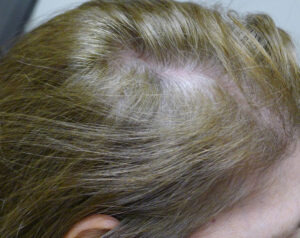
Telogen Effluvium
Sometimes this random cycle becomes synchronized resulting in a temporary hair loss, called a telogen effluvium (see photo below). This has a sudden onset, occurs three months following a stressful medical or emotional condition, and involves the entire scalp in an even fashion, causing shedding of hair and sometimes thinning all over. Examples of things that can cause a telogen effluvium are childbirth, after rapid weight loss, following surgery, or experiencing death of a family member. Certain diseases such as thyroid conditions and medications can also cause hair loss due to abnormal cycling. This type of hair loss tends to resolve spontaneously after several months, but can sometimes persist.
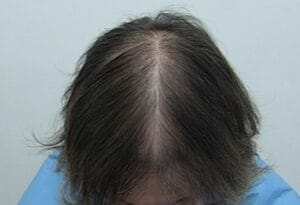
Female Pattern Hair Loss

Male Pattern Hair Loss
A common cause of hair shedding is genetic, known as androgenetic alopecia or male or female pattern hair loss (see photos). While well recognized in men as balding, women are often not aware that they can also be affected. This condition is inherited from either side of the family, and in women presents with hair loss on the top of the head and/or the temples. This condition can be treated with minoxidil and low level laser light.
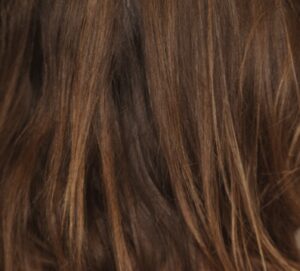
Hair Breakage
Damage to the hair shaft itself can cause breakage of the hair (see photo). Short pieces of hair may fall out in the brush or comb, and remaining broken hairs will appear frayed at their ends. Hair breakage often results from multiple insults to the hair shaft over time, and damage to healthy hair does not occur with conventional hair care products. However, certain styling techniques involving the frequent application of heat (with use of a blow dryer, flat iron, or hot comb, for example), bleaching of the hair, and chemical straighteners can all contribute to breakage over time. Luckily the hair follicle itself is not permanently harmed, and once the causative practices are stopped and the damaged hair cut off, the new hair will grow normally.
 In addition to breakage, repeated pulling of hair can result in hair loss from the root. This condition, called traction alopecia, typically causes hair loss at the scalp periphery, either in the front (see photo), or over the ears, and sometimes across the back of the neck, depending on where the pull is greatest. While reversible at first, if the damaging activity persists this type of loss can become permanent.
In addition to breakage, repeated pulling of hair can result in hair loss from the root. This condition, called traction alopecia, typically causes hair loss at the scalp periphery, either in the front (see photo), or over the ears, and sometimes across the back of the neck, depending on where the pull is greatest. While reversible at first, if the damaging activity persists this type of loss can become permanent.
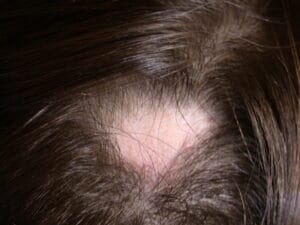
Alopecia Areata
Sometimes hair loss results in round or oval bald patches, as opposed to uniform loss all over. This type of loss has several causes, depending on the hair loss pattern and examination of the scalp surface. Bald patches can be due to a fungal infection, an autoimmune disease called alopecia areata (see photos), or a destructive process to the hair follicle. This latter group of diseases is called scarring or cicatricial alopecia (see photos), because inflammation around the hair follicle eventually results in its permanent destruction. Treatment for a fungal infection requires oral anti-fungal medication. Alopecia areata is treated with topical and injected steroids and oral medications for severe disease. The different types of scarring alopecia are treated with topical and injected steroids, antibiotics, and other oral medications depending on the type of inflammation present.
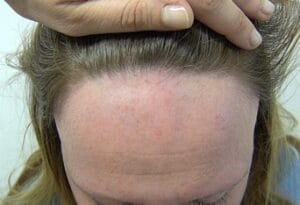
Frontal Fibrosing Alopecia
Photos of Types of Hair Loss
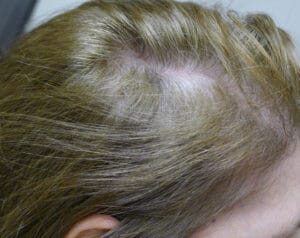

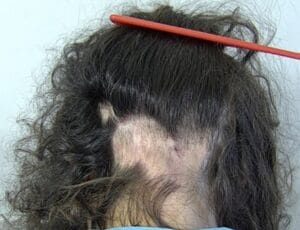
Primary Cicatricial Alopecias

Frontal Fibrosing Alopecia

Folliculitis Decalvans

Folliculitis Decalvans
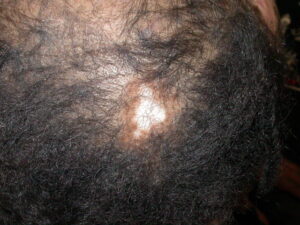
Discoid Lupus Erythematosus
Secondary Cicatricial Alopecias

Traction Alopecia

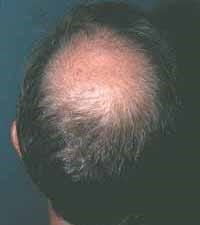
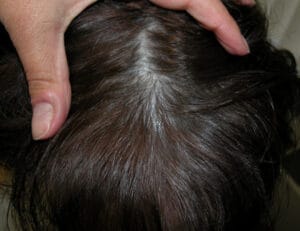

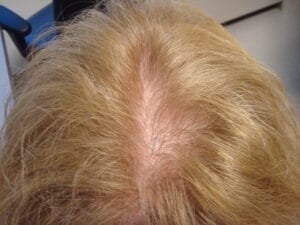

Hair Shaft Defects

Hair Breakage
Below are a series of summations on common hair disorders prepared by experts of the American Hair Research Society followed by questions our clinician members are frequently asked by patients. This information is meant to extend one's knowledge on the hair disorder or dispel myths or misunderstandings regarding common therapies used in treatment. The comments are in no way meant to substitute for a physician evaluation and diagnosis but instead are meant to augment information already received. The American Hair Research Society is not responsible for any actions taken by individuals as a result of the following information. No treatment should be initiated or discontinued based on the information imparted here but the reader is specifically referred back to his/her dermatologist/primary physician for further discussion.
